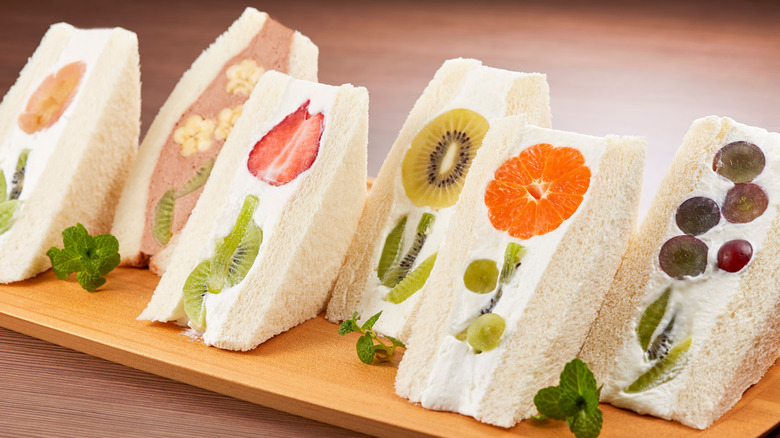The History Of Japan's Iconic Fruit Sandwich Is Rooted In Luxury
Those of us who grew up on a diet of burgers and sub fillings made with cheese, meats, and spreads, are likely to do a double take when we come across a fruit sandwich for the first time. But to those who love fruit sandwiches or fruit sandos, there is nothing unusual about enjoying a white bread sandwich filled with what looks like a creamy white filling, as well as colorful pieces of fruit so that it looks like a slice of cake — but isn't.
Fruit sandos appear to be a happy cross between a sandwich and an Asian fruit cream cake — or a Chinese bakery fruit cake as it can also be known, per Eater. But where an Asian fruit cake is made with a light sponge or chiffon cake, sandos are pulled together with slices of Japanese milk bread or shokupan. And unlike the special occasion cream cakes, a fruit sando can be consumed without ceremony — your appetite and clean hands and a clean napkin will do, making them the perfect snack or dessert, according to Web Japan. When done well, a fruit sando might even give a cream cake a run for its money, since fruit is often laid out in different artistic ways.
Fruit sandos fill a gap between healthy and indulgent
Fruit sandos first became a thing in early 20th century Japan, when fruit became "more accessible" to the public for the first time during the Taishō era, which took place between 1912 and 1926, per Japanese Food Guide. Because fruits were considered expensive luxuries during that time, they were generally used as gifts, or consumed only during special occasions. The rising popularity of fruit with the Japanese public also saw the establishment of "fruit parlors" like Ginza Sembikiya, which offers sandwich options, fruit punches, as well as parfaits, per SBS.
While fruit sandos are popular today, no one, not even those who work in fruit parlors know exactly when the sandwiches first took off. As a best guess, Ginza Sembikiya spokesman Shimizu Shibata, thinks they would have begun emerging during the 1940s. "It seems that fruit sandwiches grew out of accessibility. They're not as sweet as cake, and they don't crush, so can be eaten more easily," Shibata tells SBS. Their obvious lack of sugar also made fruit sandos a more acceptable form of affordable luxury since the country was going through wartime austerity measures during that time.
Fruit sandos today go from the cheap and cheerful snacks found in convenience stores to the teatime treats served at more upscale fruit salons. Regardless of where they are found, fruit sandos are seen as a healthy snack that has become popular with a younger, more hip generation of fans.

